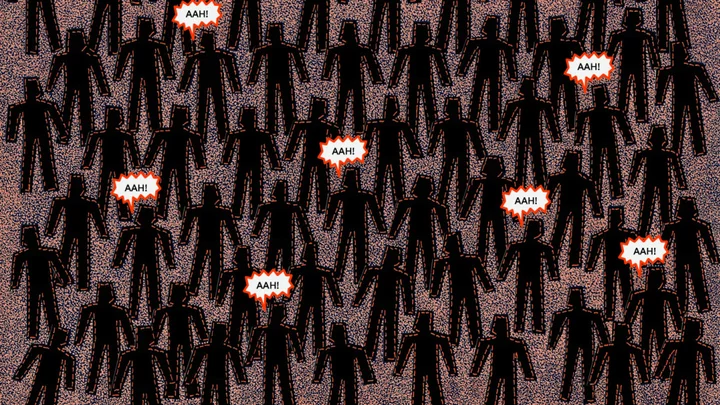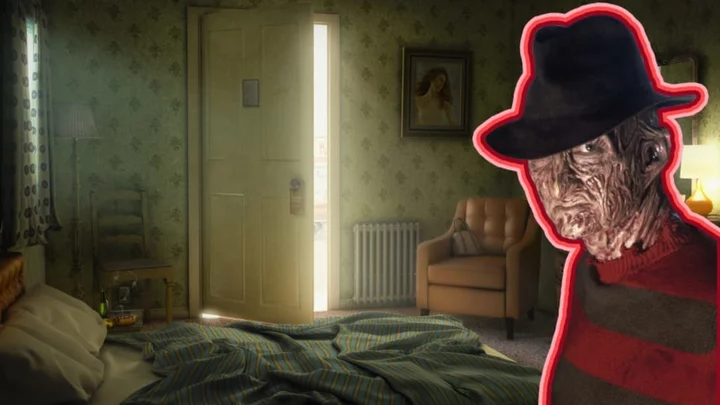Mass hysteria is a very real phenomenon with very hard-to-identify causes. Whether an entire town can’t stop dancing or people suddenly start worrying about minor marks on their windshields, these seemingly unbelievable events have had some surprising (and sometimes devastating) effects. Here’s a list of seven incidents of mass hysteria throughout history, adapted from an episode of The List Show on YouTube.
1. The Dancing Plague of 1518
More from Our Site
- •
The #@!*~ Most Swear-Filled TV Show Finales of All Time
•7 Misconceptions About Social Media
•10 of the Most Valuable Cassette Tapes From the ‘80s and ‘90s
•A Delicious History of Red Velvet Cake
A world where people can’t stop themselves from dancing is an amazing premise for a Britney Spears video, but in reality, it wasn’t so glam.
If you haven’t heard of the Dancing Plague before, think of it as the world’s most horrific flash mob. In July 1518, a woman identified only as Frau Troffea stepped outside and began dancing. And dancing. And dancing. Nothing stopped her for the better part of a week. Eventually, she was shipped off to the shrine of St. Vitus—sometimes considered the patron saint of dancing—in order to be cured. By then, more than two dozen other people from the town of Strasbourg, in what is now France, had joined her in the bizarre choreography.
Local leaders decided that the only cure was for them to just dance it out, so officials set up stages and hired musicians and even professional dancers to help the ailing citizens get it all out of their systems—but it seems that made it worse. At the height of it all, more than 400 people were afflicted with the Dancing Plague; some people even died of overexertion. Then, in September, the mysterious affliction left as suddenly as it came.
Curiously, it’s just one of several dancing plagues throughout history. Another infamous incident took place in 1374, spreading to several towns along the Rhine River, in modern-day Germany, Belgium, and the Netherlands.
Even today, we don’t know for sure what caused this strange epidemic. At the time, demonic possession was considered a strong contender, and so was the flip side—religious fervor. More contemporary historians have speculated that it may have been caused by the ergot fungi that grew on rye; when consumed in things like bread, it can cause spasms, hallucinations, convulsions and more.
But the theory that has gained the most traction to explain the dancing plague was developed by medical historian John Waller, who believed that the outbreak was a type of hysteria brought on by extreme stress. Both the Strasbourg incident and the earlier event along the Rhine were prefaced by periods of famine and death.
2. Mystery Seeds
For another incident perhaps brought about by a time of high stress, let’s think all the way back to 2020. People across the world started receiving mystery packages of seeds in the mail. Materials accompanying the packages often identified their source as China, and frequently mislabeled the contents as some type of jewelry. Texas’s agriculture commissioner, Sid Miller, advised recipients to “treat them like they’re radioactive.” He also speculated that the contents of the packages could release “a new virus of some kind.”
Chris Heath detailed the whole saga in a piece for The Atlantic. As he laid out, the most likely explanation for the mystery seeds originally centered around what’s known as a brushing scam. E-commerce merchants conduct phony transactions with accompanying positive reviews to increase their ranking on various retail sites. They have to send people something to receive the necessary tracking information, and often use inexpensive substitutes in place of the purportedly more valuable shipments—something like a bag of harmless seeds labeled as gold earrings.
The explanation seemed simple enough, but when Heath looked into it further, he found something surprising: All of the supposed “mystery” packages he investigated dated back to actual orders customers had placed and then forgotten about. It doesn’t rule out the possibility of a brushing scam for some orders, but it does raise the question of why such outlandish theories arose for what often turned out to be a simple case of delayed shipping and faulty memory. (For more on the tricks of the mind, check out our piece about the Mandela Effect.)
Would-be explanations offered for the seeds had included everything from bioterrorism to an insidious attack on American agriculture. Others thought that it was an attempt to disrupt the operations of the U.S. Postal Service in the run up to an election that would feature lots of mail-in ballots.
Here, we have to enter the domain of speculation, but it’s hard not to connect the dots to the events of the COVID-19 pandemic. It’s easy to imagine people with extra time and money stress-shopping online, probably not even aware where the seed seller they were patronizing was based. An order gets delayed for any number of reasons and then shipped as jewelry—which Heath speculates was a ruse to get around seed importation controls. When the packages finally arrive, people (through uncertainty or fear, xenophobia or elevated stress levels) seemed primed to associate China with some kind of biological danger. The desire to identify a perpetrator where one might not exist at all is a theme that arose in other cases of mass hysteria throughout history.
3. The Mad Gasser of Mattoon
In September 1944, the people of Mattoon, Illinois, were alarmed by a disturbing and rather unusual phenomenon occurring in their community. Late at night, some citizens reported suddenly smelling a sickly sweet odor flooding their homes. Almost immediately after, they and their families would fall ill or even become temporarily paralyzed. The only explanation, they decided, was that someone was pumping fumes into open windows in order to incapacitate the people inside.
This inventive villain was dubbed “the Anesthetic Prowler,” later amended to “the Mad Gasser.” After one noxious incident, a tube of lipstick and a skeleton key were discovered near the porch outside of the house—but the clues didn’t lead to anything.
The small town of Mattoon was whipped into a frenzy, with armed townspeople roving the streets at night and mass slumber parties cropping up because no one wanted to sleep alone. But even after state police were brought in to investigate, no culprit was ever apprehended.
The official determination? The strange smell was due to the large amounts of carbon tetrachloride used by a local diesel engine company involved in the war effort. The company claimed no investigation had actually been conducted, they didn’t have more than a few gallons of carbon tetrachloride on-site, and that none of their employees had ever fallen ill.
Still, the case was considered closed, and the gassings seemed to stop. Perhaps eager to avoid incriminating a large local employer, the state attorney of Coles County at first discounted the factory explanation for not explaining why it didn’t affect houses right across the street. He expressed a belief that while many of the reports likely were mass hysteria, at least a couple were legitimate. But years later he seemed to have concluded it was all a case of public hysteria fueled by newspaper reports.
4. The Seattle Windshield Pitting Delusion
For something a little less sinister, let’s turn to the Seattle Windshield Pitting Delusion. In March 1954, folks in the town of Bellingham, a city in northeast Washington state, began noticing tiny pockmarks on their car windshields. As residents speculated about the cause—theories varied wildly, from sand fleas to H-Bomb test fallout—the mysterious problem began spreading across the Evergreen State. By mid-April, even Seattle was reeling from the damage, which was now concerning enough that the governor, a team of research scientists, and even President Dwight D. Eisenhower were notified of the situation.
Law enforcement conducted an official inspection of 15,000 cars in the state and concluded that only 3000 cars had noteworthy damage. A police official commented that 5 percent of that damage was attributed to “hoodlumism.” The other 95 percent? Mere public hysteria. There may have been pits on windshields, sure, but likely because of normal, non-nefarious wear-and-tear.
However, due to the media attention, people turned these mundane marks into something more mysterious. By the end of April, the pitting reports stopped in Seattle, but began picking up elsewhere. At least eight additional states and Canada reported pits in car windshields, the glass of airplane cockpits, and even in the roofs of greenhouses in Michigan. This new wave brought on another round of theories: One scientist picked up the H-Bomb idea, but thought the marks were from remains of marine life that had been displaced by testing. Another wondered if acid from flying bugs was the culprit.
By the time the summer concluded, pit-mania died down and no definitive answer was ever found. It’s usually concluded that people were just noticing the pits that naturally develop in windows. Without the increased media attention, they might otherwise have gone ignored.
5. The Tanganyika Laughter Epidemic
If they say laughter is the best medicine, what are you supposed to do when laughter is the thing that needs treatment? In 1962, a group of students at a boarding school in what is now Tanzania were overtaken by a laughing fit.
The giggles are certainly not uncommon among school kids. But when the giggles spread to the entire school, and then to the children’s parents, and then to the neighbors, and then to nearby villages, ultimately causing over a thousand people to collapse in laughter—well, something strange is definitely afoot.
It was reported that this epidemic continued uninterrupted for more than a year, but today, most historians think that’s a bit of an exaggeration. It was serious enough that it shut the school down, and it probably did happen for that ridiculously long period of time. But it wasn’t the continuous year of laughing that it’s often made out to be. The giggles started and stopped, only to relapse or crop up in another part of town or a different village.
We also now believe that the laughs were inspired not by hilarity, but anxiety. As with the dancing disease from centuries earlier, this outbreak occurred among a very stressed population. In this case, Tanganyika had just gained its independence from British rule and the newly formed sovereign state was awash in change and uncertainty. Younger generations reported that the high expectations of their elders were impacting their mental health.
6. The Great Clown Panic of 2016
In 2016, society took its coulrophobia a step too far when it started a bona fide panic about evil clowns that weren’t actually lurking behind every corner (or sewer).
The first sighting happened in August, and it was the only real one—a clown named Gags was spotted in Green Bay, Wisconsin. Gags didn’t do anything illegal; he just stood on a corner, holding black balloons and looking creepy. It turned out he was part of a viral marketing stunt for a low-budget short film, but the clowndemic he set in motion would long outlast the hype for the movie.
A couple of weeks later, some kids in Greenville, South Carolina, reported a gaggle of scary clowns standing at the edge of the woods, whispering menacingly. In early September, clowns were said to be harassing children at a bus stop in Macon, Georgia. Similar reports popped up across dozens of other states—and yet, nary an evil clown was arrested (though a few people apparently did eventually dress up as clowns to piggyback on the hoax). There were, in fact, multiple arrests for false reports about clowns.
It got to the point where police had to issue statements reminding people not to shoot random clowns. The New York Times dubbed it a “contagion,” but it’s not the first time we’ve been infected by it. Phantom clown sightings—the official name of this phenomenon—have intermittently gripped us since at least 1981, from Honduras to England and beyond. The sightings seem to correlate with times of social unease and moral panic.
7. The Salem Witch Trials
Of course, one of the most infamous—and deadliest— cases of mass hysteria in history is the Salem Witch Trials that took place in Massachusetts in 1692. It all started when two young girls—ages 9 and 11— had strange fits that included uncontrollable screaming and violent spasms and contortions. A doctor was quick to blame “bewitchment,” a diagnosis that seemed to spread through the village like wildfire. At least five more girls came down with the same dubious symptoms, and together, they placed the blame on three people: An enslaved woman named Tituba, a beggar named Sarah Good, and Sarah Osborne, an elderly lady.
Tituba, likely knowing that no one was going to believe her anyway, may have decided that naming names was the only thing that could possibly save her. During the trial, she declared that it was all true, and that there were a number of other witches living in Salem. The hysteria set in immediately. Townspeople soon began making wild accusations. Even a 4-year-old girl was accused and thrown in a dungeon for 8 months. More of the accused confessed, thinking it was their only way out. It wasn’t, unfortunately. By the time the hysteria settled down, around 25 people had died (there’s still disagreement today about some of the exact figures). Nineteen were hanged; about five died in jail; and one man was pressed to death by stones when he refused to enter a plea.
It didn’t take long for history to realize how wrong Salem had been. Just five years later, in one of the most egregious cases of “too little too late” ever, one of the judges apologized for his role in the hysteria. Five years after that, the Massachusetts General Court declared the trials unlawful.
And now, more than three centuries later, the last remaining “guilty” woman has finally been cleared of wrongdoing. Although most victims were pardoned long ago, Elizabeth Johnson Jr., who was accused but never executed, was somehow left off the list. An 8th-grade civics class in Massachusetts took up her plight and lobbied lawmakers to make it right, which they did in 2022.
Related Tags
MYSTERY History THE LIST SHOW NEWS SCAM VIDEO DEATH LISTS DANCE FUNGI Home / LISTS








